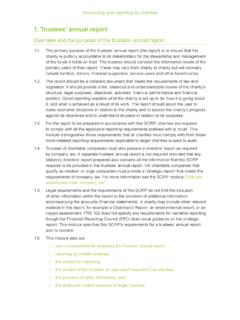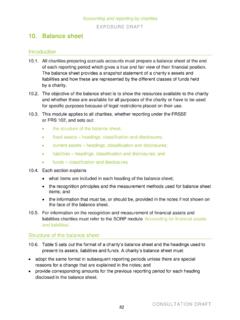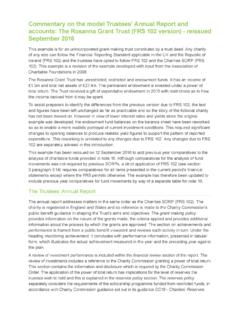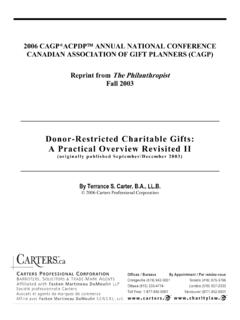Transcription of 6. Donated goods, facilities and services, including ...
1 Accounting and reporting by charities6. Donated goods, facilities and services , including The donation of goods, facilities and services to a charity provides an economic resource for use by the charity to further its aims and This module applies to all charities that have received Donated goods, facilities or services in the reporting Charities should refer to section 34 of FRS 102 for more information. This module deals with how goods, facilities and services Donated to charities are recognised, measured and disclosed in their accounts and sets out: income recognition criteria; measurement bases; accounting for Donated facilities and services , including volunteers; accounting for Donated goods and services capitalised as tangible fixed assets; accounting for Donated goods for distribution to beneficiaries; accounting for Donated goods for resale.
2 And disclosures in the notes to the Income is recognised by a charity in its accounts for goods, facilities and services Donated to it once the income recognition criteria set out in paragraph are met. When measuring the value of Donated of goods, facilities and services , practical considerations may impact on the measurement bases adopted. For example, although goods Donated for sale are normally recognised at the point of receipt, practicability may dictate that they are recognised only on their sale. Before undertaking a valuation, the charity should consider the materiality of the donations received and whether the cost involved in undertaking a valuation is justified by the benefits to the users of the accounts in terms of their better understanding the resources available to the charity and to the charity itself from having this financial Commercial discounts offered in the normal course of trade should not be recognised or disclosed as a donation in charity accounts as they are an inducement to the customer to make a purchase by lowering the price recognition Donated goods.
3 facilities and services must be recognised as income when the following criteria are met: Entitlement control over the expected economic benefits that flow from the donation has passed to the charity and any performance-related conditions attached to the donation have been fully and reporting by charities Probable it is more likely than not that the economic benefits associated with the Donated item will flow to the charity. Measurement the fair value or value to the charity of the Donated item can be measured Donated goods, facilities and services are unlikely to be subject to performance-related conditions which would result in the deferral of income until those conditions are met.
4 A restriction on the use of a donation does not prevent its recognition as Donated goods must be measured at their fair value, unless it is impractical to measure reliably the fair value of Donated item(s). When there is no direct evidence of fair value for an equivalent item, a value may be derived from: the cost of the item to the donor; or in the case of goods that are expected to be sold, the estimated resale value after deducting the cost to sell the If it is impractical to measure the fair value of goods Donated for resale or if the costs of valuation outweigh the benefit to users of the accounts and the charity of this information, the Donated goods must then be recognised when they are The terms of a gift may require the charity to make on-going use of the Donated item, so preventing its sale.
5 In such instances, there may be costs involved in removing such a restriction before the asset could be sold. This would be reflected in a lower assessment of the fair value amount than if the use of that asset was not so The cost of any stock of goods Donated for distribution to beneficiaries is deemed to be the fair value of those gifts at the time of their receipt. If the goods held are to be distributed freely or for a nominal consideration, then the carrying amount should be subsequently adjusted for any loss of service for Donated facilities and services , including If a charity is given facilities and services for its own use which it would otherwise have purchased, these must be included in the charity s accounts when received.
6 Provided the value of the gift can be measured Measuring Donated services using fair value would not be practical as such services cannot be resold and the use of fair value may result in an overstatement of the value of the donation to the charity. Donated facilities and services are therefore measured and included in accounts on the basis of the value of the gift to the Value to the charity is the amount that the charity would pay in the open market for an alternative item that would provide a benefit to the charity equivalent to the Donated item. Value to the charity may be lower than, but cannot exceed, the price the charity would pay in the open market for the and reporting by Donated facilities and services that are consumed immediately must be recognised as income, with an equivalent amount recognised as an expense under the appropriate heading in the statement of financial activities (SoFA).
7 facilities such as office accommodation or services supplied by an individual or an entity as part of their trade or profession can usually be reasonably quantified and must be included in a charity s Charities often rely on the contribution of unpaid general volunteers in carrying out their activities. However, placing a monetary value on their contribution presents significant difficulties. For example, charities might not employ additional staff were volunteers not available, or volunteers might complement the work of paid staff rather than replace them.
8 These factors, together with the lack of a market comparator price for general volunteers, make it impractical for their contribution to be measured reliably for accounting purposes. Given the absence of a reliable measurement basis, the contribution of general volunteers must not be included as income in charity However, it is important that the user of the accounts understands the nature and scale of the role played by general volunteers. Charities must include a description of the role played by general volunteers and provide an indication of the nature of their contribution in a note to the for Donated goods and services capitalised as tangible fixed Goods Donated for on-going use by a charity in carrying out its activities are recognised as tangible fixed assets with the corresponding gain recognised as income from donations within the SoFA.
9 Donated vehicles, plant or furniture are recognised as tangible fixed assets when their fair value exceeds the threshold for capitalisation set by the charity s accounting If Donated services are used in the construction of a tangible fixed asset, the value of services Donated will only form part of the construction cost of the asset when the value to the charity of the Donated services can be measured reliably. For example, the services Donated by a firm of building or electrical contractors would be valued because these services would normally be provided as part of the donor s In common with any other tangible assets, Donated goods held as tangible fixed assets must be subject to depreciation or amortisation and assessed for indications of their impairment at the reporting for Donated goods for distribution to Donated goods held by the charity for distribution to its beneficiaries should be recognised as stock.
10 With the corresponding income recognised within donations and measured at its fair and reporting by It may be necessary when valuing the donation to consider any restriction on the sale of the asset or the factors that may reduce the fair value of the asset, such as proximity to a product expiry date or the availability of lower-cost substitutes for the Donated item, for example a generic version of a drug. Donated goods held in stock for distribution must be assessed for impairment at the reporting In the reporting period in which the stocks are distributed, they are recognised as an expense and appropriately analysed as expenditure in the SoFA.











